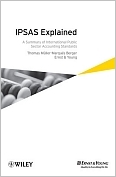| |||||
• polskie
• Zamów informacje o nowościach z wybranego tematu • kontakt |
IPSAS EXPLAINED : A SUMMARY OF INTERNATIONAL PUBLIC SECTOR ACCOUNTINGMULLER-MARQUES BERGER T. / STANDARDSwydawnictwo: WILEY, 2009, wydanie Icena netto: A practical guide to International Public Sector Accounting Standards
Opening with a thorough description of the structure and organization of the IPSASB, the book goes on to give an overview of the principles of such key topics as the accrual basis of accounting as against cash basis, the history, scope and authority of IPSAS, the strategy of the IPSASB as well as the standard-setting procedures. Additionally the various measurement bases (cost, present value, fair value) are introduced. A special focus of the book is on the implications of the current financial crisis on public sector accounting.
In the main section of the book each IPSAS (including the recently published exposure drafts) is presented in brief, focusing on the core content of the relevant standard.
Ernst & Young is a global leader in assurance, tax, transaction and advisory services, employing over 135,000 people worldwide. Thomas Müller-Marqués Berger (Stuttgart, Germany) is partner at Ernst & Young. He became a member of the International Public Sector Accounting Standards Board in January 2009. He has been a member of the IFAC Public Sector Steering Committee on Social Policy Obligations since 2003. He is a member of the FEE Public Sector Committee (European Federation of Chartered Accountants) and of the German Public Sector Committee in the Institut der Wirtschaftsprüfer (IDW). Within the Ernst & Young network he is the Global Head for International Public Sector Accounting. Table of Contents
Foreword. Contents. Abbreviations. I. Introduction: General information about IPSASs and the IPSASB. 1. The International Public Sector Accounting Standards Board (IPSASB). 1.1 General information. 1.2 Structure and organization of the IPSASB. 1.3 Objectives of the IPSASB. 1.4 Members of the IPSASB. 2. International accounting standards for the public sector. 2.1 Overview of international accounting standards for the public sector. 2.2 History of the International Public Sector Accounting Standards. 2.3 Scope of the International Public Sector Accounting Standards. 2.4 General purpose financial statements. 2.5 Authority of the International Public Sector Accounting Standards. 2.6 Strategy of the IPSASB and actual projects. 2.7 Process for reviewing and modifying IASB documents. 2.8 Procedures for developing accounting standards. 2.9 IPSASs for accrual basis of accounting and cash basis of Accounting. 2.10 Background to the introduction of international accounting standards for the public sector. 2.11 Provisions for the transition from the cash basis to the accrual basis of accounting. 3. Measurement bases in accordance with IPSASs. 3.1 Cost. 3.2 Fair value. 3.3 Present value. II. Impact of the financial crisis on public sector accounting. 1. Context and current developments. 2. Accounting issues relating to public sector interventions. III. Overview of accrual basis IPSASs. IPSAS 1: Presentation of Financial Statements. IPSAS 2: Cash Flow Statement. IPSAS 3: Accounting Policies, Changes in Accounting Estimates and Errors. IPSAS 4: The Effects of Changes in Foreign Exchange Rates. IPSAS 5: Borrowing Costs. IPSAS 6: Consolidated and Separate Financial Statements. IPSAS 7: Investments in Associates. IPSAS 8: Interests in Joint Ventures. IPSAS 9: Revenue from Exchange Transactions. IPSAS 10. Financial Reporting in Hyperinflationary Economies. IPSAS 11: Construction Contracts. IPSAS 12: Inventories. IPSAS 13: Leases. IPSAS 14: Events after the Reporting Date. IPSAS 15: Financial Instruments: Disclosure and Presentation. IPSAS 16: Investment Property. IPSAS 17: Property, Plant and Equipment. IPSAS 18: Segment Reporting. IPSAS 19: Provisions, Contingent Liabilities and Contingent Assets. IPSAS 20: Related Patty Disclosures. IPSAS 21: Impairment of Non-Cash-Generating Assets. IPSAS 22: Disclosure of Information About the General Government Sector. IPSAS23: Revenue from Non-Exchange Transactions (Taxes and Transfers). IPSAS 24: Presentation of Budget Information in Financial Statements. IPSAS 25: Employee Benefits. IPSAS 26: Impairment of Cash-Generating Assets. IV. Overview of current Exposure Drafts. IPSAS ED 36: Agriculture. IPSAS ED 37: Financial Instruments: Presentation. IPSAS ED 38: Financial Instruments: Recognition and Measurement. IPSAS ED 39: Financial Instruments: Disclosures. IPSAS ED 40: Intangible Assets. IPSAS ED 41: Entity Combinations from exchange Transactions. V. Cash Basis IPSAS. Cash Basis IPSAS: Financial Reporting Under the Cash Basis of Accounting. Further reading. 208 pages, Hardcover
Po otrzymaniu zamówienia poinformujemy pocztą e-mail lub telefonicznie, |


